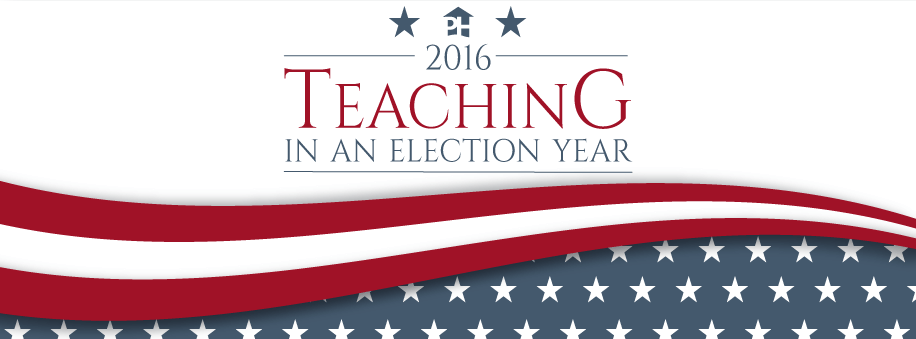
This year’s election cycle is an amazing opportunity for you to explore the power of language and the impact it has on world events. From analyzing news reports for hidden biases to examining speeches for the techniques that make them powerful, there are dozens of opportunities to use the election to teach important language arts concepts in a fresh and relevant context.
This is the first in an ongoing series of resources to help you use this event as a teaching tool. Be sure to visit the English Teacher’s Free Library to get free posters and lesson plans to help you get the most out of this season.
1. Teach Critical News Watching – Slant, Spin, and Bias
One of the most important skills students need to learn is critical thinking. A close examination of the news and other nonfiction sources while looking for unintentional biases and deliberate manipulations of facts will make your students more informed citizens and better readers. Direct your students to read two articles on the same topic from different news sources to show them how the same factual topic can be viewed from different perspectives, or ask them to find logical fallacies in the arguments of pundits and talking heads.
If you’re looking for resources to help you examine these topics, Prestwick House’s Reading and Analyzing Nonfiction: Slant, Spin, and Bias gives you everything you need to teach a unit on understanding how language is used to influence—or distort—a reader’s opinions.
2. Use political speeches to talk about rhetoric and the power of language
You can find many political speeches online or in inexpensive books like Prestwick House’s Essential American Documents Vol. 1 & 2. Have your classes use these important documents to discover how forceful rhetoric and skillful use of language has helped to shape policy and sway public opinion. This will add a new level of relevance to your students’ appreciation, understanding, and discussion of the media messages they constantly confront in their lives.
You can also expand the lesson into an entire unit with Rhetorical Devices or Rhetoric, Logic and Argumentation, two books that focus on giving your students the skills to craft convincing arguments using powerful techniques of language.
3. Work with other departments
Everyone appreciates the importance of interdepartmental cooperation, but it’s hard to find the time; everyone has his or her own needs and priorities. This is the perfect opportunity to start a conversation with the members of your school’s social studies department. They probably have all kinds of great ideas on how you can work together. Consider getting a list of primary sources that they’re using, letting them know about any historical texts that you’re teaching, and seeing what major projects they’re working on this year to determine how you could tie those topics into your curriculum.
4. Teach satire using current events
From SNL to the funny pages, satire is everywhere during election season. Draw connections between current events and the great classics of satire like A Modest Proposal or Animal Farm by introducing your students to political satire from fake news programs like The Daily Show, websites like The Onion, or comics. Supplement these modern sources with a complete survey of the genre with our giant PowerPoint presentation, Introduction to Satire, which includes both classic and modern sources and gives you a ton of material to lead fantastic classroom discussions.
5. Tie the concepts to standards.
If you’re having trouble coming up with ideas to bring the election into the classroom, take a look at your state’s standards and consider how the election can be used to build meaningful activities. For example, the CCSS standard for reading literacy LR9-10.5 reads: Analyze in detail how an author's ideas or claims are developed and refined by particular sentences, paragraphs, or larger portions of a text (e.g., a section or chapter).
You could address this Standard by exploring speeches by recent or historical politicians to see how they’ve developed these ideas in their speeches. This is a great way to address these skills without merely "teaching to the test."
6. Set Ground Rules
It’s easy to get tripped up in discussing the election with your students. It’s important to set ground rules about civil discourse and make sure that you personally don’t take sides or show personal bias. You may want to avoid letting your students know where you stand on the issues, and stress that we are analyzing the message and not the messenger, the techniques and not the opinions.
Students will, of course, have their own preferences in the election. These resources will help you help them to express themselves with power and clarity, while at the same time responding maturely and intelligently to arguments that express a different viewpoint.
Because of the potential problems in dealing with issues that students and parents can take personally, it might be a good idea to put these guidelines in writing, and talk with your principal or department chair if you anticipate any major problems arising.
7. Be creative!
There are dozens of fun writing prompts and creative in-classroom discussion ideas that you could use throughout the year. Here are some of our favorite writing prompts and classroom ideas-- share yours in the comments!
- What literary character would you vote for?
- What would you do as president?
- What’s important to you as a voter?
- Practice writing political speeches for imaginary candidates
- Should teenagers be allowed to vote?
- The vocabulary of elections
- Election Scavenger Hunt
- Hold a debate in class
- Take the “I Side With” online quiz, and write about something that surprised you.
- Explore the role of advertising in politics
Check out our list of great resources to help you make this presidential election more than just a choice between candidates!